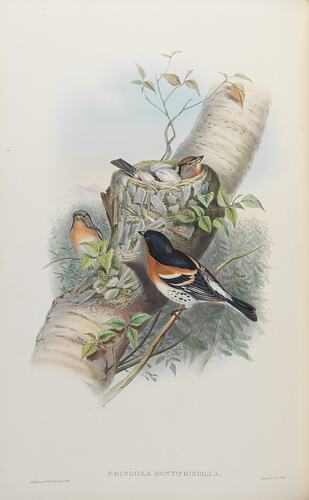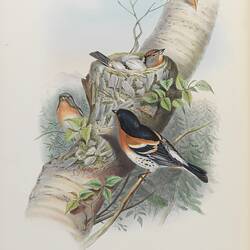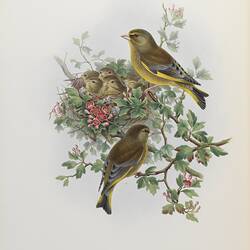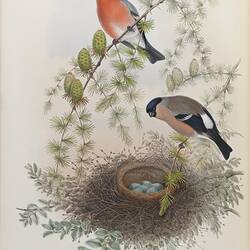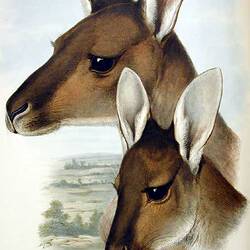Summary
The Birds of Great Britian by John Gould, F.R.S., &c. In five volumes, Volume III. London: Printed by Taylor & Francis, Red Lion Court, Fleet Street. Published by the author, 26, Charlotte Street, Bedford Square. 1873.
'The Birds of Great Britian' was authored and published by ornithologist John Gould (1804 - 1881). Gould completed this work following the success of 'The Birds of Europe' and 'The Birds of Australia'. He also saw a need for a work that included images of young birds, both for scientific endeavours and the general readers, as this had been largely ignored in previous texts.
Completed between 1862 - 1873, 'The Birds of Great Britian' was originally issued in 25 parts, comprised of 367 hand-coloured lithographic plates. In total there were nearly 'two hundred and eighty thousand illustrations' completed for this work, a feat that Gould thought would astonish his readers. The first print run had 397 subscribers, the largest of any of Gould's works. This particular volume continues from volume 2 in detailing the insessors, a now obsolete taxonomic order that includes perching birds and songbirds. It includes species such as wagtails, pipits, larks, buntings, finches, ravens and woodpeckers. Most of the plates are credited to Gould and two of his long-term employees, Henry Constantine Richter and William Hart, with contributions from Joseph Wolf.
Henry Constantine Richter (1821 - 1902) was employed as an illustrator by Gould, following the death of his wife and main illustrator Elizabeth Gould in 1841. Richter went on to work with Gould and contributed greatly to many of his publications, including 'The Birds of Australia', 'The Mammals of Australia' and 'The Birds of Asia', amongst others. However, Richters' greatest work is considered 'The Birds of Great Britian' as he contributed almost 300 of the 367 plates, along with Hart. Richter worked with Gould for 40 years, until Goulds' death in 1881, and produced over 1600 hand-coloured lithographs.
William Hart (1830 - 1908) was an artist and lithographer for Gould from 1851. Although he aspired to become a medical doctor, Hart lacked the funds to continue his studies. Harts' work as a colourist is noteworthy as he shared Goulds' propensity for intense use of colour.
Physical Description
Hard-cover volume with green and gold morocco binding measuring 37cm high. Comprised of 76 hand coloured lithographic plates and 142 pages of letterpress, including title page and list of illustrations.
Significance
Following the successful sell out of 'The Birds of Europe', Gould returned to his 'old love', publishing a work dedicated to the birds of Great Britian. This was to appease those dedicated followers who had missed out on purchasing volumes of 'The Birds of Europe'. The text focused heavily on birds depicted with nests, chicks and young birds in their natural habitat. This was considered a focal point for the work and an important edition for scientists and readers, as it had been largely ignored by previous authors.
In producing 'The Birds of Great Britian' Gould found his match in respected natural history illustrator Joseph Wolf (1820 - 1899). Wolf was passionate about creating works from life and encouraged Gould and his illustrating team to do the same. He developed his skill and passion growing up in the forests of Rhenish Prussia (now Germany), where he studied and hunted native wildlife. Wolf had a unique ability to combine his acute knowledge of his subject's physiology and behaviours with accurate but beautiful zoological illustrations. Wolf contributed roughly 26 of the illustrated plates, mainly in volume 1, which contains members of the Raptores family. Wolfs' reputation as a highly skilled illustrator made 'The Birds of Great Britian' even more valuable and sought after.
More Information
-
Collecting Areas
-
Author
-
Illustrator
-
Illustrator
-
Illustrator
-
Category
-
Discipline
-
Type of item
-
References
KU Libraries n.d., William Matthew Hart (1830-1908), The University of Kansas, accessed 20 February 2025, <[Link 1]> Sauer G C (1982) John Gould, the bird man: a chronology and bibliography. Lansdowne Editions, Melbourne. Stephens M (2019) William Matthew Hart (1830-1908). Australian Museum website, accessed 20 February 2025. Stephens M (2018) Henry Constantine Richter (about 1821-1902). Australian Museum website, accessed 08 February 2025. Stephens M (2018) Josef Wolf (1820-1899). Australian Museum website, accessed 12 February 2025. The British Museum (n.d.) Rhenish Prussia, The British Museum website, accessed 08 February 2025. Tree I (1991) The bird man: the extraordinary story of John Gould. Ebury Press, London.
-
Keywords
Ornithology, Birds, Scientific illustration, Natural history illustration
